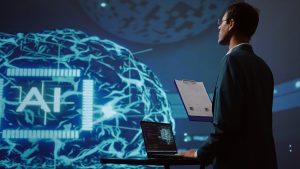Artificial Intelligence (AI) is changing how we live, learn, and work. For young learners eager to explore this future, AI projects for students are a fun and powerful way to get started. Whether you’re predicting marks, creating a chatbot, or analysing data, these projects help you turn curiosity into hands-on experience.
With free tools and a bit of guidance, you can begin building your own AI models today. Let’s see how you can start your journey — step by step.
Why Students Should Build AI Projects
1. Learn by Doing
Working on AI projects for students helps you understand how AI really works. Reading about algorithms is helpful, but applying them makes everything click. When you see your project make a smart prediction, you realise how amazing machine learning can be.
2. Build Real Skills
AI projects teach valuable skills like data analysis, Python coding, and machine learning basics. These are in-demand abilities that can give you a strong foundation for future careers.
3. Stand Out in Studies and Careers
Completing AI projects shows initiative and creativity. You can add them to your portfolio, showcase them during interviews, and stand out from other students.
4. Become a Better Problem Solver
AI encourages logical thinking. Each project pushes you to break down a problem, experiment, and find smart solutions — a skill useful in any subject.
What You Need to Start Your AI Projects
You don’t need to be a tech genius or buy costly software. Here’s everything you’ll need to start building AI projects for students.
1. Basic Understanding
Learn a few essential ideas before you begin:
-
Artificial Intelligence (AI): Making machines think and act smart.
-
Machine Learning (ML): Teaching systems to learn from data.
-
Neural Networks: Systems inspired by how the brain works.
-
Data: The key to all AI learning.
You can explore these basics through free platforms like Kaggle Learn, Coursera, or Google’s Teachable Machine.
2. Tools and Libraries
Start with tools designed for beginners:
-
Python: The easiest programming language for AI.
-
Google Colab: A free online space to run Python code.
-
Libraries:
-
Pandas and NumPy for data handling.
-
Matplotlib for data visualisation.
-
Scikit-learn for simple machine learning models.
-
3. Free Datasets
AI projects need data to learn. You can download free datasets from:
How to Build AI Projects for Students (Step-by-Step)
Follow these steps to create your first project from scratch.
Step 1: Choose a Project
Pick something simple but meaningful. Some beginner-friendly AI projects for students include:
-
Predicting exam marks from study hours.
-
Classifying emails as spam or not.
-
Recognising handwritten digits.
-
Recommending movies or books.
Step 2: Collect and Explore Data
Once you choose your idea, collect a dataset. Use Python’s Pandas library to explore it — check for missing values, errors, or duplicates.
Step 3: Build and Train the Model
Here’s where your AI starts learning! Use Scikit-learn to train a simple model. For example, a linear regression model can predict grades.
Step 4: Test and Improve
Check your model’s accuracy with test data. If results are weak, try adding more data or using a different algorithm.
Step 5: Visualise and Share
Graphs and charts help people understand your results quickly. Use Matplotlib for this, then share your project on GitHub, LinkedIn, or ShikshaNation.
Popular AI Projects for Students (Ideas & Inspiration)
| Project Idea | What You’ll Learn |
|---|---|
| Chatbot using Python | Learn how to make computers understand and reply to text. |
| Handwritten Digit Recognition | Understand image processing and neural networks. |
| Movie Recommendation System | Discover how platforms like Netflix suggest content. |
| Spam Detector | Learn text classification and filtering. |
| Sentiment Analysis Tool | Use AI to detect emotions in reviews or tweets. |
Each of these AI projects for students can be completed using free tools and basic Python knowledge.
Tips for Success in AI Projects
1. Start Small
Focus on one project at a time. Even a simple model teaches valuable lessons.
2. Learn from Tutorials
Follow YouTube or blog tutorials to build confidence, then try adding your own creative twist.
3. Work with Others
Collaborate with friends or join AI clubs. Sharing ideas helps you learn faster and stay motivated.
4. Document Your Progress
Write down what worked, what failed, and what you discovered. Reflection improves learning.
5. Share and Showcase
Upload your work to ShikshaNation, GitHub, or social media. It’s a great way to inspire others and build your personal brand.
Common Challenges and How to Overcome Them
| Challenge | Solution |
|---|---|
| Struggling with coding | Start with no-code tools like Teachable Machine. |
| Confused by maths | Focus on understanding ideas before formulas. |
| Poor accuracy | Use more data or adjust your model. |
| Feeling lost | Join online AI communities for help and feedback. |
The Future of AI Learning
AI is reshaping education, business, and even art. Students who begin early gain a major advantage in understanding how intelligent systems work.
By exploring AI projects now, you’re preparing for tomorrow’s world — one where creativity, logic, and data come together to solve real problems.
Conclusion
Starting AI projects for students is one of the best ways to learn about technology and innovation. You don’t need to be an expert — just curious, consistent, and ready to experiment.
So take that first step. Pick a project, open your laptop, and start building. Your first AI model could be the start of something extraordinary.







